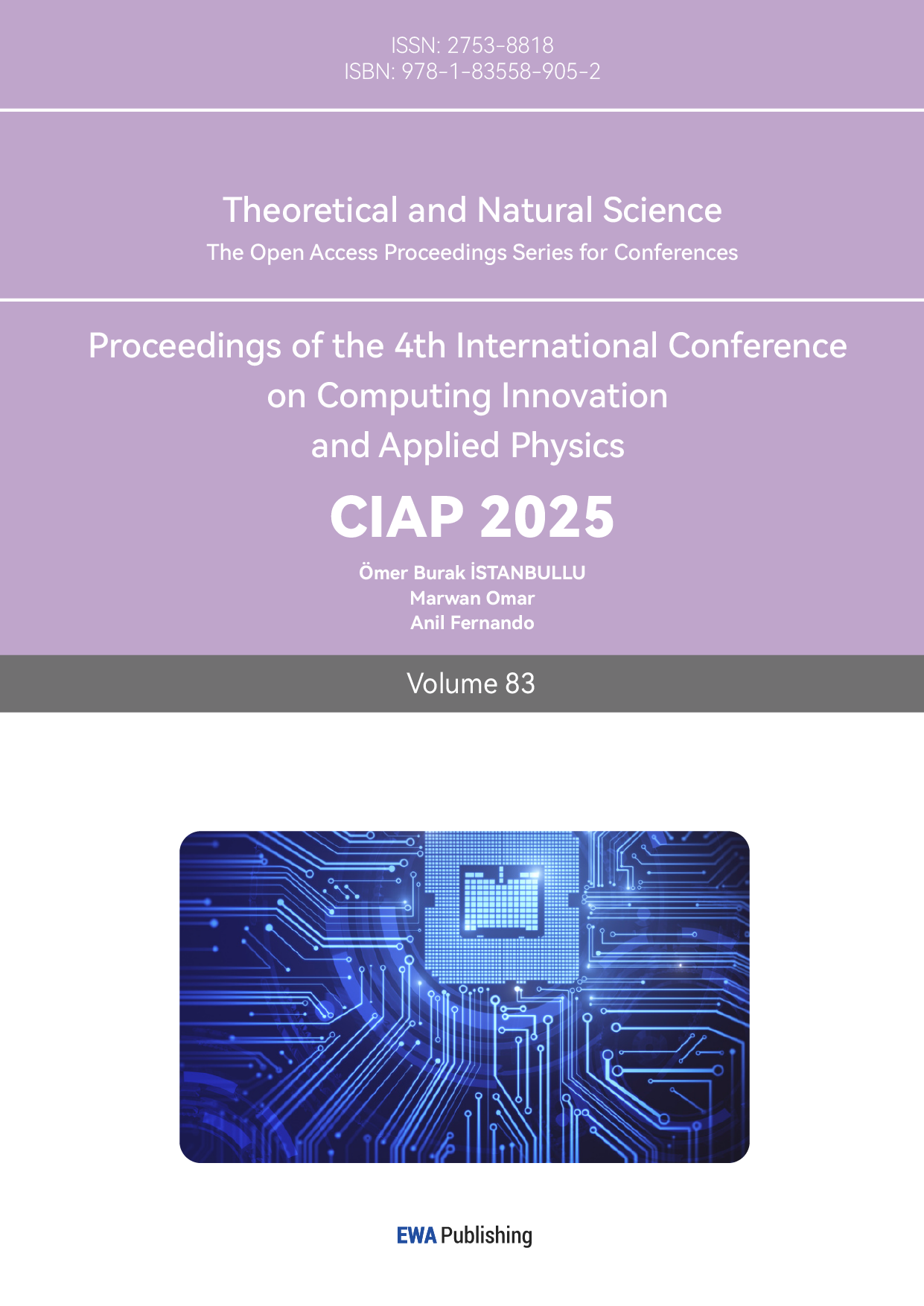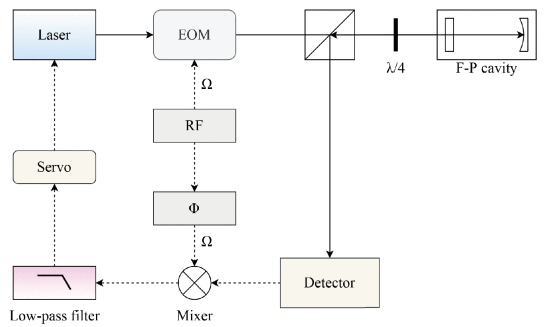1. Introduction
Lasers often lack the stability required for advanced research and production needs due to factors such as temperature increases during operation and disturbances from both artificial and natural sources, which significantly affect the output laser frequency. Numerous studies have explored solutions to this issue, with PDH technology emerging as the most popular approach due to its universal applicability. Many researchers are now digging deeper into this technique. So this research is intended to gather some of the important studies and glean different methods in further improving the PDH technology, in the wake of which provide possible future research direction in this field. Nowadays most researches dig into a very specific aspect of PDH technology, like using double modulation to work in two ranges to cooperate, using one but modulating at multiple phases to get more detailed information, as well as replacing some of the component of the device including using Fano resonance instead of F-P cavity, which provide practical and promising visions for pioneer laser devices[1-3]. This effort represents a meaningful step toward consolidating existing resources, facilitating comparisons, and examining potential connections between various studies. Given the scarcity of comprehensive research on this subject, reviewing these independent studies is essential to gather the necessary information and develop new advancements based on previous findings. Further researches upon this are likely to absorb the advantages of previous researches so that the PDH technology can be more suitable for practical high-standard applications, and enterprises and research institutes can use this for better detection and industrial processing.
2. Basis of PDH technology
2.1. Principle
The PDH technology generally uses a real-time feedback system to test whether the output laser frequency is up to the standard, and generates an error signal to adjust the laser cavity. As shown in Fig 1, after being emitted by the laser, the light will pass an electrical optical modulator (EOM) to have phase modulation. Then it goes through a polarization beam splitter (PBS), becomes polarized, and enters the optical cavity, such as an F-P cavity. It will finally come out and be polarized again so that it goes another way in the PBS. The detector collects this light and it will be demodulated at the same frequency to make an error signal, which is filtered by the low-pass filter and at last it is sent to a controller to physically change the feature of the laser cavity, forming a negative feedback system to improve its stability. The error signal expression is as follows:
\( E≈-\frac{4}{π}\sqrt[]{{P_{c}}{P_{s}}}\frac{Δω}{Δν} \) (1)
\( ∆ ω \) is the frequency change; \( ∆ ν \) is the full width at half maximum of the F-P cavity; \( {P_{C}} \) is the carrier power; \( {P_{s}} \) is the sideband power
Figure 1: PDH technology principle[4]
The effect of this technique is obvious and inspiring. An experiment testing the effects of PDH technology on the SA200-5B type F-P cavity (1.5 GHz) demonstrates that, within 10 seconds before and after locking, there is a substantial difference. As shown in Fig 2, when operating freely, the frequency fluctuation is around 3.5MHz, and after frequency locking, it is within 600 kHz.

Figure 2: Comparison in using PDH or not[5]
2.2. Enhancement
Several advancements have been made by integrating related techniques in optics to improve the efficiency of PDH technology. Coherent PDH technology combines coherent detection into PDH technology which can be fit for the interrogation of fiber sensor arrays and sensing low-power signal. The frequency components involved in the process of PDH are transferred from the former optical domain into the radio frequency domain. The power for detection is obviously lower (15 dB than the previous one), providing greater potential for various applications [4].
Simultaneously, active PDH technology mixes the injection locking technology to enhance the precision of the sensors and improve the signal-to-noise ratio. It puts the weak standard signal into the cavity to act with oscillator, so that the laser can be stabilized from the source.
3. Deeper PDH technology
3.1. Special PDH technology
Now the PDH technology is not limited to the original principle in many ways. Basically, for example, there is an experiment on using an acousto-optic modulator (AOM) instead of former electric-optic ones applied in the system of PDH technology. For the phase modulation in this technique, when using an electric-optic modulator, all the effects on the light such as slight polarization and the sideband of the light can lead to wrong analysis after demodulation. This new approach basically uses an AOM operating in the Bragg diffraction regime (AOM-B) as an external phase modulator. The AOM-B driver in the specific experiment consists of a signal generator, an attenuator, and a power amplifier. It not only does phase modulation but also adjusts the light amplitude [6]. The laser here is a diode laser (New FocusVortex 6000, Newport Corp), and a satisfying result is shown in Fig 3.
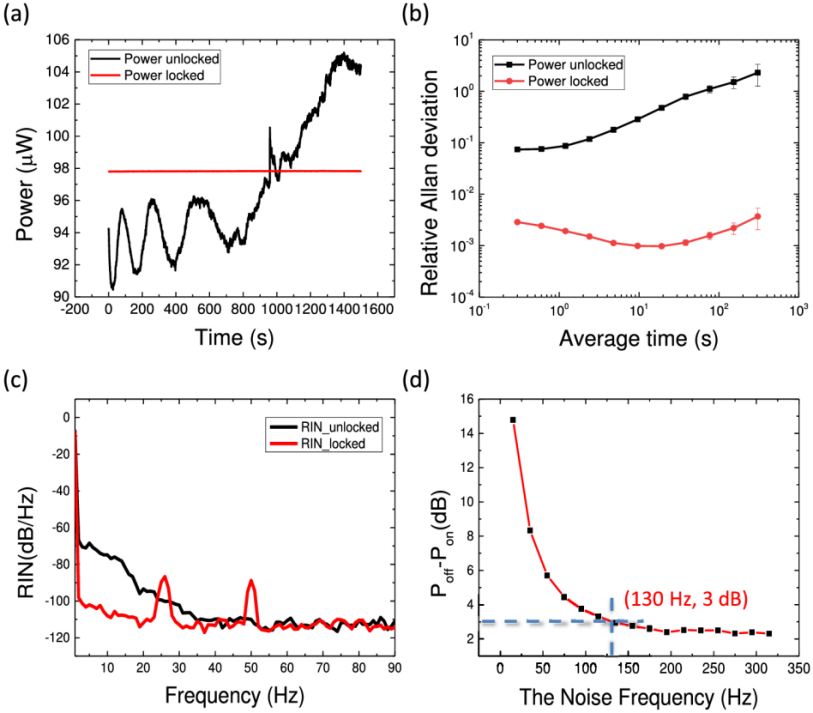
Figure 3: Power stabilization of the cavity coupling light (a) Detected power in front of the cavity. Black line: power unlocked, red line: power locked. (b) Corresponding relative Allan deviations of the measured power. (c) Relative intensity noise signals. (d)Relative power difference at the introduced noise frequency when the servo is on/off[6]
This method contrasts with another approach demonstrated by Baryshev, which uses a different acousto-optic modulator operating in the Raman-Nath diffraction regime. Unlike the previous technique, this system is less affected by environmental factors like temperature and electrical noise. Also, it is insensitive to light polarization and produces only a single sideband, significantly improving the precision of the error signal by reducing noise.
There are also methods that involve selecting or modifying the optical cavity to achieve different models. Research has shown that microcavities, particularly microcylinder cavities, exhibit relatively low noise caused by thermal motion, approaching the error signal quality of well-established PDH technology[3][7]. This technique is more complicated because it uses Fano resonance, but it also benefits from its complexity to some extent. The so-called whispering gallery mode(WGM) can provide a precise locking source, but still can generate noise from heat, affecting the system a lot because of its small size. This research, however, identifies a connection between disturbances in various models and resonance frequencies, thus comparing this to the error signal as the traditional PDH technology to adjust the cavity with much more precision[3].
3.2. Two depths modulation
While researchers explore different models in PDH technology, there have also been advancements aimed at enhancing the feedback system’s foundation. The traditional PDH technology usually faces the disadvantage of a narrow linear dynamic range and susceptibility to interference. So here comes an adaptive stabilization method based on two modulation depths shown in Fig 4.
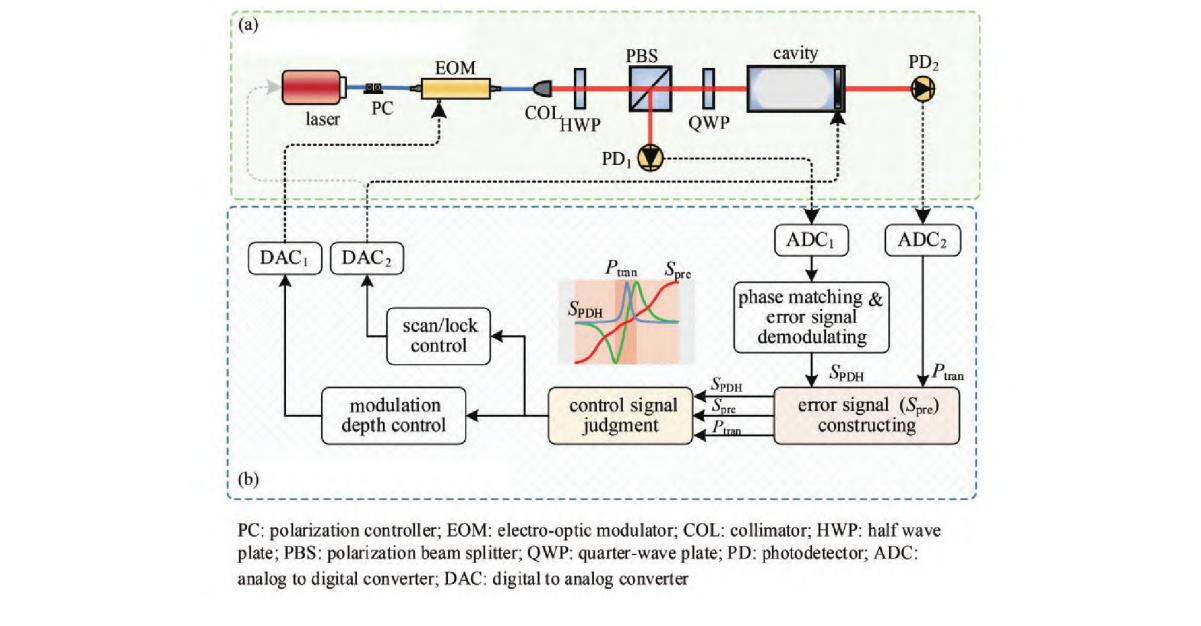
Figure 4: PDH locking method based on double modulation depths[1]
This method allows for two relatively independent feedback loops to operate within a single laser system. The system retains the traditional feedback approach, but it collects light from both the front and back of the cavity into two detectors with distinct detection ranges. Simply, the one with the larger range ( \( {S_{pre}} \) ) is for pre-locking, used for putting the frequency to the range of the more precise one ( \( {S_{PDH}} \) ). Then, the precise locking works, making it better than the traditional one. Due to this design, the system reaches both precision and adaptive, along with a quick switch in both models(<30μs), which can realize long-term high-quality locking[1].
3.3. Orthogonally demodulated PDH method
Besides that, there is also a tricky way to improve the PDH technology system. The traditional PDH technology also tends to face some issues from hardware, like some unavoidable phase deviation. In this approach, shown in Fig 5, the generator for modulating frequency is changed to a direct digital frequency synthesizer(DDS) and output modulate signal or demodulate signal in three phases as 0°, 180° and 270°. Among them, the 0° is used for modulation.
The most important point in this research is that a relatively big inherent error exists due to the equipment itself. So it lets the signals of the 180° and 270° to operate phase sensitive detection at first, to exam the inherent error. Then, the equipment will use the 270° one to do the regular test and consider the former inherent error so that it can output a more precise error signal. Though this is proven to be able to reduce inaccuracy of the hardware, it would have periodic imperfect due to its unique software[2].
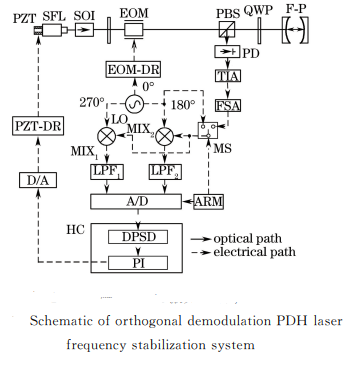
Figure 5: Orthogonal demodulation PDH laser frequency stabilization system[2]
4. Application and discussion
The original PDH technology has already been put into research for application for its adaptive and precise for many occasions. It is recognized as one of the most extensively used techniques in the field. There has been actual equipment like the short fiber resonant optic gyroscope that uses PDH technology’s principle to add higher frequency on its signal to test more slight movement[8]. It directly uses this technology as an amplifier of the movement of the device itself. Additionally, commercially ready lasers, such as the Yb:YAG thin-disk laser, are compatible with PDH technology, enhancing their already excellent optical properties for use by institutions and companies[9]. Moreover, PDH technology has spurred research in other fields, such as conditioning and testing power couplers in giant superconducting radio-frequency accelerators[10]. PDH technology remains a burgeoning topic of interest. Although numerous studies have explored this technology, many are still in the initial stages of investigation. Most focus on identifying specific problems and addressing them by expanding on the technology. However, the challenge lies in improving the entire system comprehensively, rather than focusing on isolated issues. A more integrated approach is needed to achieve further advancements in stabilization, with the goal of enhancing the precision and stability of lasers.
5. Conclusion
This research briefly discusses the PDH technology as well as those enhancements and improvements done by different kinds of researches like enriching error signal or changing cavity. Several weaknesses in the technology have been identified and addressed, though this discussion does not encompass all the progress made in this field. Many developments remain unsatisfactory for researchers, as they lack comprehensive and complete solutions. While PDH technology holds great promise and can be applied broadly, much more exploration is required. However, without delving into the theoretical derivations of these studies, this paper can only offer methodological insights rather than substantive improvements. The focus here is on methods already in use. Further theoretical analysis could reveal greater commonalities among these approaches, leading to more effective advancements.
References
[1]. Yan Liping, Zhang Zhewei, Xie Jiandong, Lou Yingtian & Chen Benyong. (2023). Adaptive PDH Frequency Stabilization Method with Large Linear Dynamic Range Based on Two Modulation Depths. Acta Optica Sinica(19), 123-134.
[2]. Su Juan, Jiao Mingxing, Jiang Fei, Xing Junhong. Research on Laser Frequency Stabilization Techniques Using Orthogonally Demodulated Pound-Drever-Hall Method[J]. Laser & Optoelectronics Progress, 2018, 55(8): 081404.
[3]. Yaohui Xu, Haotian Wang, Jun Guo, Jianing Zhang, Wei Zhou, and Deyuan Shen, "Laser frequency stabilization based on Fano resonance in a microcylinder cavity," Opt. Lett. 48, 4288-4291 (2023)
[4]. X. Zhan, Z. Wang, S. Kumar, C. Marques, X. Li and R. Min, "The Application of Pound–Drever–Hall Technology in High-Resolution Sensing—A Review," in IEEE Sensors Journal, vol. 23, no. 7, pp. 6427-6438, 1 April1, 2023, doi: 10.1109/JSEN.2023.3244941.
[5]. Wang Xinlong, Gao Jun, Ye Hanli and Wang Chensheng. Research on Laser frequency stabilization with PDH technique based on F-P cavity. Laser Technology 1-10.
[6]. Yong Zeng, Zhuo Fu, Yang-Yang Liu, Xiao-Dong He, Min Liu, Peng Xu, Xiao-Hong Sun, and Jin Wang, "Stabilizing a laser frequency by the Pound–Drever–Hall technique with an acousto-optic modulator," Appl. Opt. 60, 1159-1163 (2021).
[7]. WANG Meng-yu ,JIN Xue-ying ,WANG Jing ,CHEN Li-ming ,WANG Ke-yi. (2017). Analysis of the Pound-Drever-Hall Frequency Stabilization Technique Based on a Whispering Gallery Mode Optical Microsphere Cavity. ACTA PHOTONICA SINICA (07), 61-68.
[8]. Xiaojun Jin, Yi Lin, Ying Lu, Huilian Ma, and Zhonghe Jin, "Short fiber resonant optic gyroscope using the high-frequency Pound–Drever–Hall technique," Appl. Opt. 57, 5789-5793 (2018).
[9]. Manuel Zeyen, Lukas Affolter, Marwan Abdou Ahmed, Thomas Graf, Oguzhan Kara, Klaus Kirch, Adrian Langenbach, Miroslaw Marszalek, François Nez, Ahmed Ouf, Randolf Pohl, Siddharth Rajamohanan, Pauline Yzombard, Karsten Schuhmann, and Aldo Antognini, "Injection-seeded high-power Yb:YAG thin-disk laser stabilized by the Pound-Drever-Hall method," Opt. Express 31, 29558-29572 (2023).
[10]. Zhou Xian, Feng Liwen, Zhuang Dehao, et al. RF resonant ring locking using Pound-Drever-Hall technique[J]. High Power Laser and Particle Beams, 2018, 30: 123002.
Cite this article
Shen,T. (2025). Review of Further Advancement in Pound-Drever-Hall (PDH) Technology Development. Theoretical and Natural Science,83,216-221.
Data availability
The datasets used and/or analyzed during the current study will be available from the authors upon reasonable request.
Disclaimer/Publisher's Note
The statements, opinions and data contained in all publications are solely those of the individual author(s) and contributor(s) and not of EWA Publishing and/or the editor(s). EWA Publishing and/or the editor(s) disclaim responsibility for any injury to people or property resulting from any ideas, methods, instructions or products referred to in the content.
About volume
Volume title: Proceedings of the 4th International Conference on Computing Innovation and Applied Physics
© 2024 by the author(s). Licensee EWA Publishing, Oxford, UK. This article is an open access article distributed under the terms and
conditions of the Creative Commons Attribution (CC BY) license. Authors who
publish this series agree to the following terms:
1. Authors retain copyright and grant the series right of first publication with the work simultaneously licensed under a Creative Commons
Attribution License that allows others to share the work with an acknowledgment of the work's authorship and initial publication in this
series.
2. Authors are able to enter into separate, additional contractual arrangements for the non-exclusive distribution of the series's published
version of the work (e.g., post it to an institutional repository or publish it in a book), with an acknowledgment of its initial
publication in this series.
3. Authors are permitted and encouraged to post their work online (e.g., in institutional repositories or on their website) prior to and
during the submission process, as it can lead to productive exchanges, as well as earlier and greater citation of published work (See
Open access policy for details).
References
[1]. Yan Liping, Zhang Zhewei, Xie Jiandong, Lou Yingtian & Chen Benyong. (2023). Adaptive PDH Frequency Stabilization Method with Large Linear Dynamic Range Based on Two Modulation Depths. Acta Optica Sinica(19), 123-134.
[2]. Su Juan, Jiao Mingxing, Jiang Fei, Xing Junhong. Research on Laser Frequency Stabilization Techniques Using Orthogonally Demodulated Pound-Drever-Hall Method[J]. Laser & Optoelectronics Progress, 2018, 55(8): 081404.
[3]. Yaohui Xu, Haotian Wang, Jun Guo, Jianing Zhang, Wei Zhou, and Deyuan Shen, "Laser frequency stabilization based on Fano resonance in a microcylinder cavity," Opt. Lett. 48, 4288-4291 (2023)
[4]. X. Zhan, Z. Wang, S. Kumar, C. Marques, X. Li and R. Min, "The Application of Pound–Drever–Hall Technology in High-Resolution Sensing—A Review," in IEEE Sensors Journal, vol. 23, no. 7, pp. 6427-6438, 1 April1, 2023, doi: 10.1109/JSEN.2023.3244941.
[5]. Wang Xinlong, Gao Jun, Ye Hanli and Wang Chensheng. Research on Laser frequency stabilization with PDH technique based on F-P cavity. Laser Technology 1-10.
[6]. Yong Zeng, Zhuo Fu, Yang-Yang Liu, Xiao-Dong He, Min Liu, Peng Xu, Xiao-Hong Sun, and Jin Wang, "Stabilizing a laser frequency by the Pound–Drever–Hall technique with an acousto-optic modulator," Appl. Opt. 60, 1159-1163 (2021).
[7]. WANG Meng-yu ,JIN Xue-ying ,WANG Jing ,CHEN Li-ming ,WANG Ke-yi. (2017). Analysis of the Pound-Drever-Hall Frequency Stabilization Technique Based on a Whispering Gallery Mode Optical Microsphere Cavity. ACTA PHOTONICA SINICA (07), 61-68.
[8]. Xiaojun Jin, Yi Lin, Ying Lu, Huilian Ma, and Zhonghe Jin, "Short fiber resonant optic gyroscope using the high-frequency Pound–Drever–Hall technique," Appl. Opt. 57, 5789-5793 (2018).
[9]. Manuel Zeyen, Lukas Affolter, Marwan Abdou Ahmed, Thomas Graf, Oguzhan Kara, Klaus Kirch, Adrian Langenbach, Miroslaw Marszalek, François Nez, Ahmed Ouf, Randolf Pohl, Siddharth Rajamohanan, Pauline Yzombard, Karsten Schuhmann, and Aldo Antognini, "Injection-seeded high-power Yb:YAG thin-disk laser stabilized by the Pound-Drever-Hall method," Opt. Express 31, 29558-29572 (2023).
[10]. Zhou Xian, Feng Liwen, Zhuang Dehao, et al. RF resonant ring locking using Pound-Drever-Hall technique[J]. High Power Laser and Particle Beams, 2018, 30: 123002.





